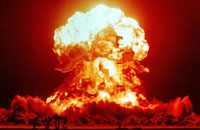Russia and USA Ready To Finally Lay Down Their Nuclear Arms
On April 6, Dmitry Medvedev started his official visit to Slovakia. In Bratislava the President will participate in the celebrations in honor of the 65th anniversary of liberation of Slovakian capital by the Red Army. On April 8 he will arrive in Prague where he and President Barak Obama will sign a historic nuclear arms reduction treaty.

Both Presidents were supervising 10 rounds of negotiations regarding the treaty, and the work is finally completed.
“This is a huge event that will deeply and positively influence the two countries’ ability to deal with other issues concerning not only high ranking officials, but ordinary people as well,” stated Sergey Prikhodko, aide to the Russian President. “The treaty marks the transition to a higher level of cooperation between the US and Russia, and lays a foundation for qualitatively new strategic relations between the two countries.”
Russia Today: Behind the shine of Obama's new nuclear doctrine
The treaty prepared for signing is a large package of documents (over 160 pages) that includes the treaty itself, and a protocol specifying the provisions and prescribing the order of implementation. The package also includes addendums detailing all possible nuances of the treaty. Some addendums are not a part of the signed treaty and can be edited by experts after the treaty is signed. A special Bilateral Consulting Committee will be created to maintain the treaty and solve any related issues.
Under the treaty, both countries will reduce its strategic nuclear weapons. Seven years after the treaty takes effect, the quantities would not exceed the following:
- 700 units for intercontinental ballistic missile (IBM), submarine-launched ballistic missile (SLBM) and heavy bombardment aircraft (HBA);
- 1550 warheads for them;
- 800 units for deployed and non-deployed launchers IBM, SLBM, and HBA.
"This is the Russian initiative that allows creating of a good stimulus for liquidation and re-equipment of strategic weapons,” an expert told Izvestia.
The numeric parameters provided for in the treaty will allow an opportunity to preserve and develop the Russian group of strategic nuclear weapons. Experts believe that the required deterrence level will be guaranteed.
At the moment the US has 798 ballistic missiles and strategic bombers, while Russia has 566. The US has 1188 missile launchers while Russia has 809. The US is to dismantle 4500 warheads, and Russia will eliminate 3900.
Washington yielded to Moscow and linked offensive and defensive strategic arms although in the beginning the Presidents agreed that ballistic missile defense is a topic for a different dialogue.
The Kremlin notes that the treaty is being signed when both parties have certain levels of strategic defensive systems. If one party changes the level of defense, the other party may raise the issue of further participation in the reduction of strategic offensive weapons. This means that if Washington decides to deploy missile defense system in Eastern Europe, Moscow can suspend the treaty.
The largest difficulty is not in linking offensive and defensive weapons, but in the ratification procedure. As soon as Medvedev and Obama sign the document, the ratification procedure will be commenced by the State Duma, Federation Council and US Senate. Ideally, this process should be conducted simultaneously, but we have to be realistic.
“Of course, it is important that the document is ratified simultaneously, but we do not expect it to be ratified the same day. We have different relations with Americans now. We trust each other much more than we used to. We do not feel that they can fool us,” Prikhodko said.
The Kremlin believes that different timeframes of ratification will not be tragic.
“It is not a political issue,” Prikhodko stressed. “Political will has been already expressed by the countries. The treaty preparation was hard, but it was sincere mutual work.”
The Russian President’s Aide believes that “hawks” in both countries will oppose the document. “At some point, unfortunately, both parties underestimated the activity and involvement of the opponents of the development of Russian-American relations. Many of them used the critique of the future treaty as a tool for creating political infighting between the two countries,” he added.
At any rate, on April 8 large delegations of officials and military officers will gather in Prague for the treaty signing ceremony. After the signing, Medvedev and Obama will conduct a press conference. Then the parties will discuss the timeframe for Medvedev’s reciprocal visit to the US. Obama visited Russia last summer. The Russian leader may visit the US this summer or fall.
Izvestia
Subscribe to Pravda.Ru Telegram channel, Facebook, RSS!


